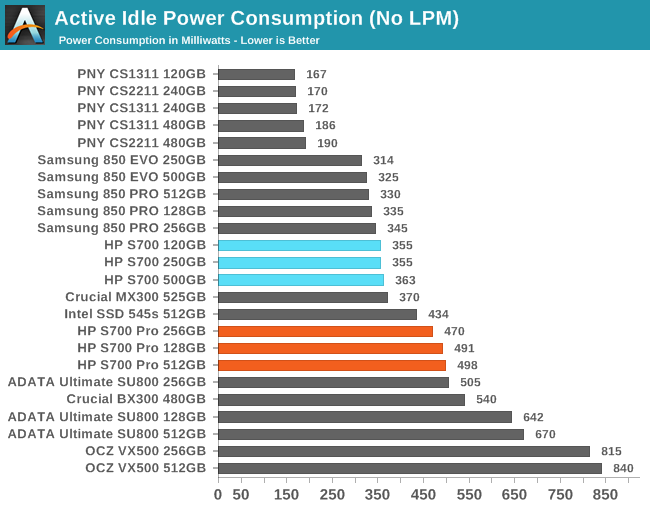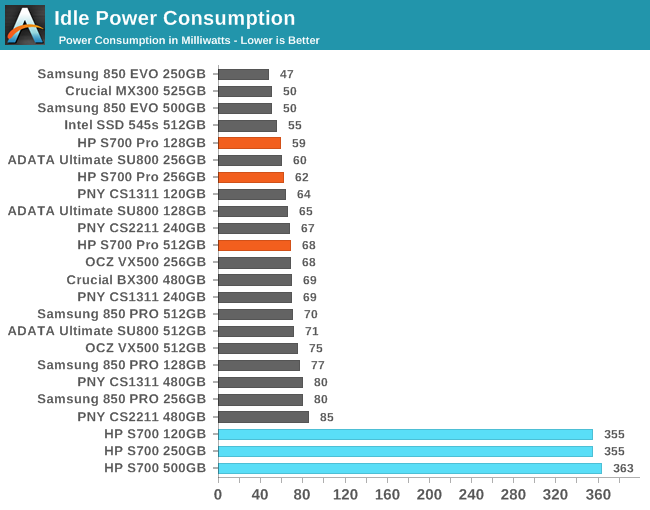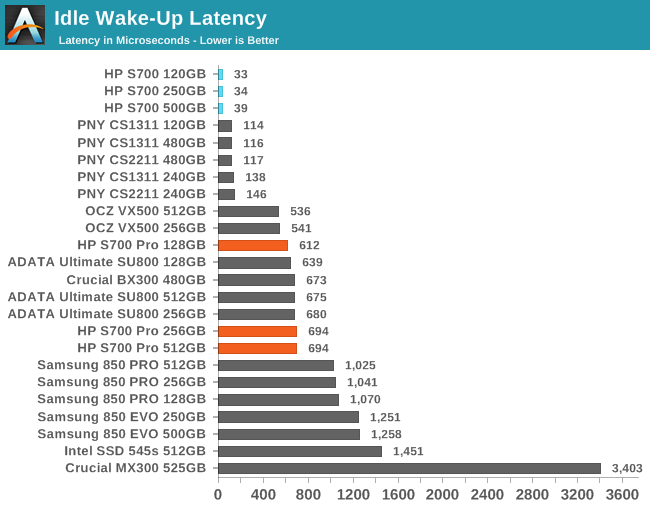The HP S700 And S700 Pro SSD Review
by Billy Tallis on September 7, 2017 9:00 AM ESTPower Management
Real-world client storage workloads leave SSDs idle most of the time, so the active power measurements presented earlier in this review only account for a small part of what determines a drive's suitability for battery-powered use. Especially under light use, the power efficiency of a SSD is determined mostly be how well it can save power when idle.
SATA SSDs are tested with SATA link power management disabled to measure their active idle power draw, and with it enabled for the deeper idle power consumption score and the idle wake-up latency test. Our testbed, like any ordinary desktop system, cannot trigger the deepest DevSleep idle state.
Idle power management for NVMe SSDs is far more complicated than for SATA SSDs. NVMe SSDs can support several different idle power states, and through the Autonomous Power State Transition (APST) feature the operating system can set a drive's policy for when to drop down to a lower power state. There is typically a tradeoff in that lower-power states take longer to enter and wake up from, so the choice about what power states to use may differ for desktop and notebooks.
Active idle is representative of a typical desktop, where none of the advanced PCIe or SATA link or NVMe power saving features are enabled and the drive is immediately ready to process new commands. The idle power consumption metric is measured with PCIe Active State Power Management L1.2 state and SATA Device-Initiated Power Management enabled and NVMe APST enabled.


Drive capacity has little effect on idle power consumption. Active idle power draw comes down mostly to the choice of controller. The Phison S10 is the best, followed by Samsung's SSDs and then the HP S700 with the SM2258XT. The S700 Pro with its DRAM more than 100mW extra at idle.
With link power management enabled, the S700 Pro has good power savings but doesn't stand out from the crowd. The S700 apparently fails to engage the slumber power state and thus power doesn't go down at all. This makes the S700 a poor choice for mobile use, but this may simply be a firmware bug that could be fixed.

The idle wake-up latency of the S700 is minimal, since it never actually enters a low-power state. The Phison S10 drives are by far the fastest to wake up from the slumber state, and the S700 Pro falls in the second tier of drives that wake up in less than 1ms.










54 Comments
View All Comments
ddriver - Thursday, September 7, 2017 - link
Why is it "Pro"? Performance - nope, endurance - nope, warranty - nope, sounds better - nailed it.HP's brand new Pro bested by Samsung's ancient Evo...
MajGenRelativity - Thursday, September 7, 2017 - link
It's better than the 700 non-Pro, so it warrants that in relation to its other counterpart.mooninite - Thursday, September 7, 2017 - link
You nailed it. Unfortunately HP will sell units because 1) they'll ship them in their own systems they sell and 2) they have blindly loyal customers.MajGenRelativity - Thursday, September 7, 2017 - link
I assume that's why HP went to the trouble of making an SSD? :Psyxbit - Thursday, September 7, 2017 - link
Making? They're not making anything here. They're repackaging another company's engineering efforts.Samus - Thursday, September 7, 2017 - link
The only blindly loyal customers out there are Lenovo's. On the whole, HP's mid-high end systems are the best on the market. Both companies...all companies, make crap at the low end. The business and professional market are where HP just destroys Lenovo is serviceability, reliability, and support. Lenovo simply wins on price. That's why people love them. Because they are cheap. And orange.sonny73n - Friday, September 8, 2017 - link
You sound spiteful. Are you hurt because Lenovo took over as the world's top ranking PC manufacturer after Q2 2013? HP has only gone downhill after that because all HP products have been made in China since who knows when.There's no company I dislike more than a domestic one with products being made overseas then shipped back and sold at home.
barleyguy - Friday, September 8, 2017 - link
You can't have your cake and eat it too. The reality is that western labor costs about 10 times as much as Chinese labor, and it's a price competitive market. If an HP laptop was built domestically, it would cost hundreds of dollars more, and most people would buy the cheaper one built in China.You either get cheap electronics or you get domestic manufacturing. At this point in time, you can't have both.
FunBunny2 - Friday, September 8, 2017 - link
-- The reality is that western labor costs about 10 times as much as Chinese laborthat made a bunch of difference years ago, but if you look at the FRED data, labor has become a vanishingly small part of production cost. if you're relying on bleeding labor to make money, you won't make much money.
Alexvrb - Sunday, September 10, 2017 - link
Exactly. Also there are lots of regions of the US where labor is cheap (rural low cost of living parts of RTW states for example). I suspect other factors such as taxes and regulation drive them to move production overseas more so than the hourly rate of workers.